In-depth interpretation of the NFT layout of traditional brands
Original Author: Tang Yuan
Original Author: Tang Yuan
The encrypted asset market is bearish, and the demand in the NFT market has fallen sharply, and the transaction volume in the secondary market has shrunk significantly. Dune Analytics data shows that in August, the trading volume of the Ethereum version NFT on OpenSea was only 273,000 ETH, equivalent to 472 million US dollars, compared with the peak of 1.604 million ETH (approximately 4.857 billion US dollars) in January this year, the transaction volume has shrunk 90%.
The NFT market is cooling down, but traditional brands are accelerating their entry into NFT.
On August 2, Gucci’s official Twitter announced that some of its US stores will add a new encrypted asset payment method - the native token ApeCoin (APE) of the leading NFT project Bored Ape Yacht Club (BAYC Bored Ape). At that time, Gucci customers in the United States can use APE to purchase goods in stores by using the payment infrastructure provided by the payment company BitPay. This is also the first luxury brand to publicly support the NFT project.
On August 1st, Tiffany officially announced the launch of a new NFT project, NFTiff, for creating custom pendants and NFT digital artwork similar to the final jewelry design. NFTiff is generated based on the Cryptopunk NFT, and Tiffany's designer restored the NFT image of the Cryptopunks series on the chain with a physical necklace pendant. This time, Tiffany's product that combines NFT on the chain with the entity has been very popular once it was launched. 250 NFTiff NFTs were sold out on the day it went online on August 5. The issue price of each NFT was 30 ETH (about 54,000 US dollars). ).
So, what are the forms of traditional brand layout NFT? How is it different from NFT projects native to the encrypted market? How is the operation of NFT projects issued by traditional brands? In this issue, Web3 honeycomb will be sorted out one by one.
first level title
Why do traditional brands favor NFT?
NonFungible released its NFT report for the second quarter of 2022. The report shows that in the Q2 quarter, the scale of NFT transactions was US$8 billion, the number of NFTs sold was 10.1 million, the number of buying users was 1.172 million, the number of active wallet addresses was 1.247 million, and the average price of NFT transactions was US$798.
Compared with the first quarter of this year, the relevant data performance of NFT has declined, but the number of projects and the overall activity of users have already made a qualitative leap compared with the same period last year. With such a basic market, traditional consumer brands began to give up their onlooker attitude and deployed NFT one after another.
For traditional commodities, NFT technology can be used to solve the problem of counterfeit and shoddy products. As a non-homogeneous token, NFT has the characteristics of scarcity and indivisibility. It can allow some content or artwork to obtain a digital ID with a unique identity through blockchain confirmation, and its creators can decide on their own. The issued quantity of a work is numbered, and every link of circulation and transaction is completely recorded through the blockchain, and the data is open and transparent, which can protect both the creator and the holder.
Therefore, NFT can be used as a digital identity certificate for any product in the real world, which is the theoretical "everything can be NFT". Since NFT is traceable, verifiable, non-tamperable and non-forgeable, it is the most favorable endorsement for the authenticity and uniqueness of the product. This is especially important for products that require traceability (such as luxury goods, high-end alcohol, etc.), not only to prevent counterfeiting, but also to better use its characteristics to authenticate the value of its scarce commodities.
For example, in real life, high imitations of luxury goods are flooding the market, and consumers often look for professional appraisal agencies when identifying authenticity. If the information of these luxury goods is stored on the blockchain and made into NFT or corresponding NFT virtual products on the chain, then consumers can view the public information on the chain (including the raw materials of the product, the place of production, the quantity of production, etc. ) to distinguish authenticity.
For brands, NFT, as the new darling of encrypted users and the younger generation, has its own traffic.
On the one hand, brands can use NFT for marketing, digitally develop their own IP, make NFT a bridge for brands to link users, use NFT as a medium to build more scenarios, and bring new product experience.
On the other hand, the inherent scarcity of NFT can even increase the value of a brand or product, because scarcity itself brings a premium for the product. Taking luxury goods as an example, its limited-edition products are often sought after by consumers. After the introduction of NFT products, it can break the homogeneous competition of mass-produced products, match consumer preferences from multiple dimensions, realize customization, and further increase scarcity.
For users, NFT brings the possibility for users to participate in brand building, allowing users to change from the previous role of consumers to the role of builders who develop together with the brand. For example, the holders of Stickman NFT mfers, in order to increase the popularity of the NFT project, they made offline peripheral products at their own expense, and even placed advertisements for it.
first level title
What are the ways for traditional brands to enter NFT?
Encrypted native NFT projects are completely opposite to the expectations and development routes of traditional brand layout NFT. The former hopes to link products in the virtual world on the chain to offline application scenarios, while the latter hopes that NFT can become the entrance to the virtual world on the chain.
The starting point of the encrypted native NFT project is issued by the creator, and the development route is driven by community users. The chain and the offline world develop together. It is hoped that based on the NFT IP on the chain, it can be extended to the offline physical world, giving more real usage scenarios . This is a development process from virtual to real and from bottom to top. For example, the NFT project Boring Ape BAYC has been made into offline clothing, skateboards, shoes and other peripheral products, and the stickman mfer has offline cafes and so on.
Traditional brands that issue NFT hope to use it to enter the Web3 or Metaverse world, build more online virtual spaces based on brand IP in the real world, and let brand IP have a place in the world on the chain. Its development route is guided by the brand . This is a development process from real to virtual and from top to bottom. For example, the beauty brand Estee Lauder released the small brown bottle NFT (Advanced Night Repair) at the Metaverse Decentraland Fashion Week event. The user’s Metaverse virtual avatar can enter the small brown bottle and get a wearable NFT. The brown bottle endows a shining and bright face, bringing users a new metaverse experience.
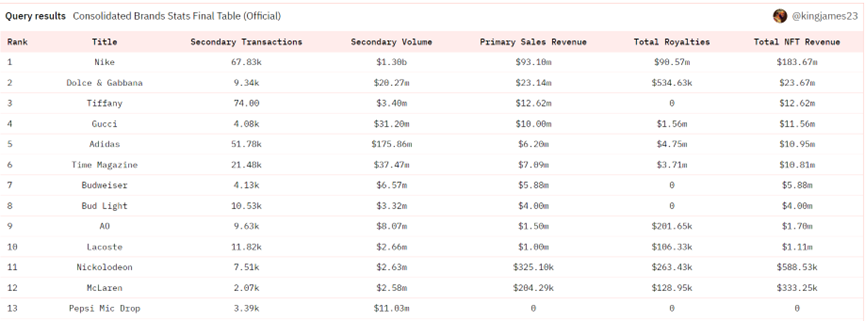
image description
Brand NFT revenue statistics from DuneAnalytics
For brand companies, embracing NFT is not only a product in the form of NFT, but also a systematic project. Based on the unique attributes of NFT, companies can create a series of new interactive scenarios that could not be realized before, which can be consumption scenarios, social scenarios or game scenarios. These scenarios can be self-built or rely on external cooperation. In addition to focusing on the gameplay and value of NFT as a digital asset, brands pay more attention to how to activate a new brand marketing system and user ecology through NFT.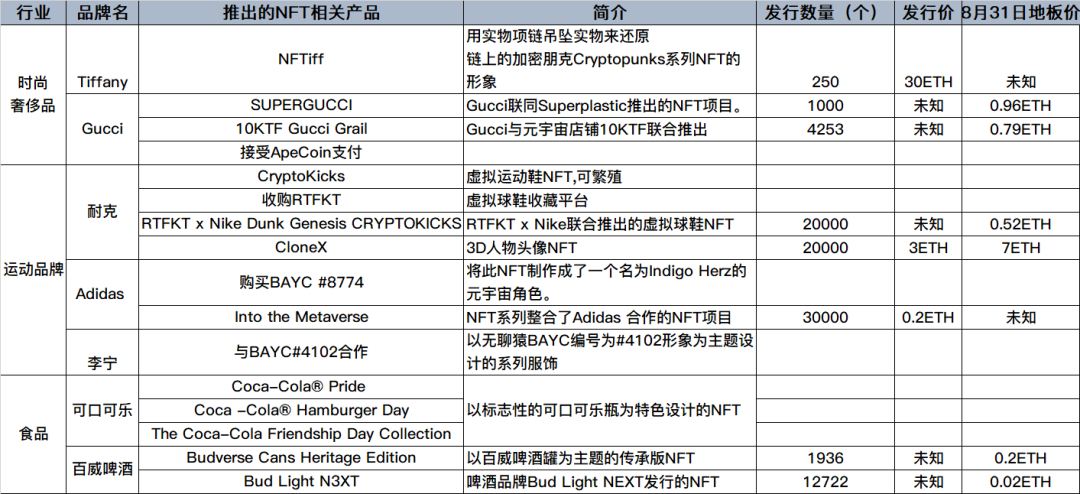
image description
The routes of traditional brands to develop the NFT market are also different, which can be divided into the following categories:
secondary title
From Virtual to Real: Obtain NFT IP Authorization to Produce Physical Products
Domestic trendy brand China Li Ning bought Boring Ape #4102 to make peripherals
In April this year, the domestic trendy brand China Lining won the Boring Ape BAYC #4102, and then launched the "China Lining Boring Ape Trend Sports Club" series of clothing. This series of clothing is designed with the image of #4102 Boring Ape as the theme. Combining ape elements, clothes and shoes were launched offline, and a pop-up event of "boring is not boring" was also held. #4102 Boring Ape became the manager of Li-Ning's pop-up store.
Jeweler Tiffany&Co makes CryptoPunk pendant
On August 5th, Tiffany & Co launched the first set of NFT works "NFTiffs". This series of NFTs is limited to 250 pieces, each priced at 30ETH, and the current market price is about 55,000 US dollars. The NFTiff series NFT is generated based on CryptoPunkNFT, and Tiffany's designers restored the image of CryptoPunk NFT on the chain with physical necklace pendants.
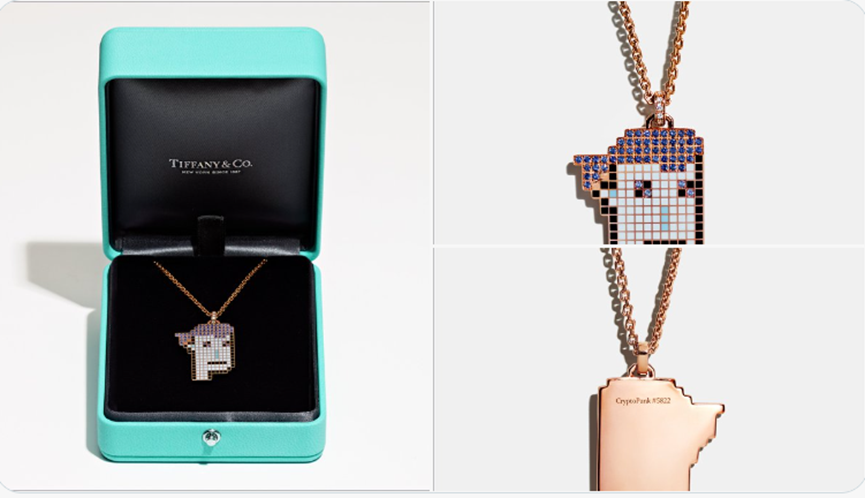
image description
It should be noted that NFTiff is only open to purchase qualifications for owners of CryptoPunks series NFT. This means that CryptoPunks holders need to spend 30ETH to purchase the NFTiff series of NFTs, and then receive a physical pendant customized by Tiffany. Despite the limited purchase conditions, NFTiff was sold out on the day it went live on August 5th. Such marketing methods brought Tiffany 7500 ETH in revenue, which is about 12 million US dollars.
secondary title
From Reality to Virtuality: Using NFT to Expand the Metaverse Layout
Nike plays a trilogy around NFT
The early layout of NFT by sports brand Nike mainly revolved around virtual shoes.
In 2019, Nike launched the first virtual sneaker NFT "CryptoKicks". Each pair of virtual sneakers is an NFT, and its color, style and other attributes are recorded on the chain, and the ownership is transferred with the transfer of NFT. CryptoKicks later added gameplay. The various designs of sneakers can continue to evolve. It borrowed from the gameplay of the first-generation blockchain game representative "CryptoKitties", which can pair sneakers to generate new sneakers. The difference is that Nike will This kind of gameplay is derived offline. As long as the manufacturer can produce, the descendants of these sneakers can be produced as a pair of customized physical sneakers.
In December 2021, Nike announced the acquisition of RTFKT, a virtual sneaker collection platform, at the time when NFT was booming, and the metaverse concept was ready to go. Before the acquisition, RTFKT has launched the 3D character avatar NFT series CloneX, which has become a blue-chip project in the NFT market.
CloneX is specially designed for the interactivity of the metaverse world. Because it uses 3D modeling technology, it tries to combine NFT with AR devices. RTFKT later planned to develop virtual clothing, trying to make CloneX's NFT characters wear shoes and hats in the Metaverse world. The company's development and planning routes are heading towards the metaverse, and Nike's acquisition of it undoubtedly paves the way for its entry into the metaverse.
In February of this year, Nike and RTFKT jointly released the first Ethereum-based virtual sneaker NFT series RTFKT*Nike Dunk Genesis CryptoKicks (hereinafter referred to as RTFKT*NDGC), which is mainly used for virtual human wearable devices in the Metaverse world. The total number of RTFKT*NDGC issued is 20,000, and the initial selling price is 3 ETH on average. Now its floor price in OpenSea is 0.54 ETH, which is about 864 US dollars.
Adidas sells NFT as Metaverse Pass
Adidas (Adidas) has a more precise goal when laying out NFT-directly hitting the metaverse.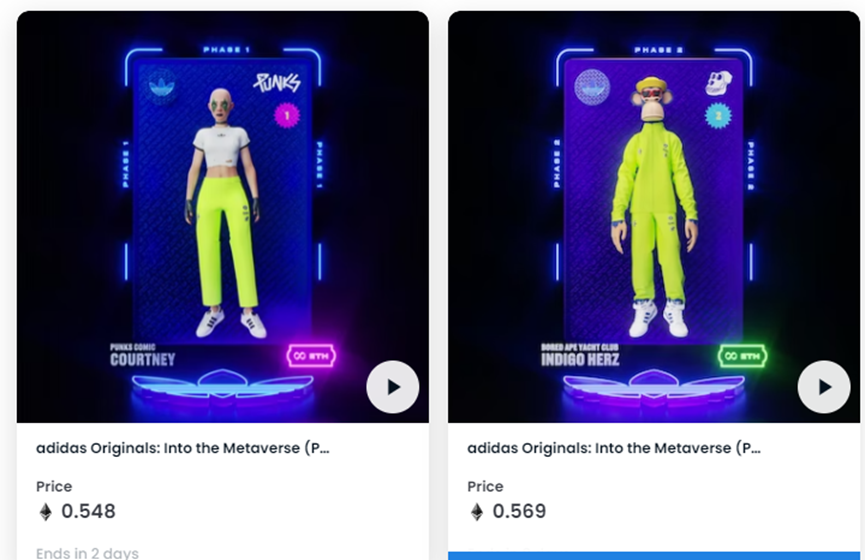
image description
Intothe Metaverse image
In that month, Adidas released the "Into the Metaverse" series of NFTs, with a total of 30,000. The NFT series uses Indigo Herz as the character image and prepares different costumes for them.
Issuing NFT is not the ultimate goal of Adidas, but building a metaverse brand space is. At the core of The Sandbox in the metaverse, Adidas has a "Land". In the future, users who hold NFT can serve as a free pass to enter the virtual space, and avatars can wear related virtual clothing equipment in The Sandbox. Buyers who purchase Adidas' NFT series not only have the opportunity to enter the exclusive fan club, but also receive these NFT physical clothes.
Coca-Cola NFTizes core elements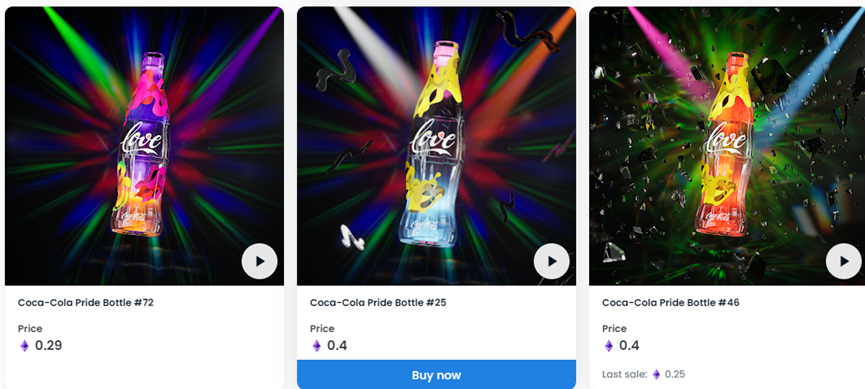
image description
Coca-Cola®Pride Series
Prior to this, Coca-Cola also launched a Christmas snow globe NFT. This collection of NFTs features falling snow, the iconic Coca-Cola polar bear, and more.
It is worth mentioning the Coca-Cola Friendship Loot Box (Coca-Cola Friendship Box) NFT, which players can use in the Metaverse Decentraland. The box includes a classic Coca-Cola retro refrigerator, a red Coca-Cola delivery uniform (can be worn in Decentraland ), a friendship card (modeled after the Coca-Cola game cards of the 1940s), and a soundvisualizer (plays the sound of a bottle being opened, a drink being poured over ice, and the usual bubbly sounds found in carbonated drinks). Coca-Cola said that each NFT in the friendship box is to commemorate the core elements of the Coca-Cola brand, but they have given a new interpretation of these elements in the virtual world.
Budweiser NFTizes canned elements
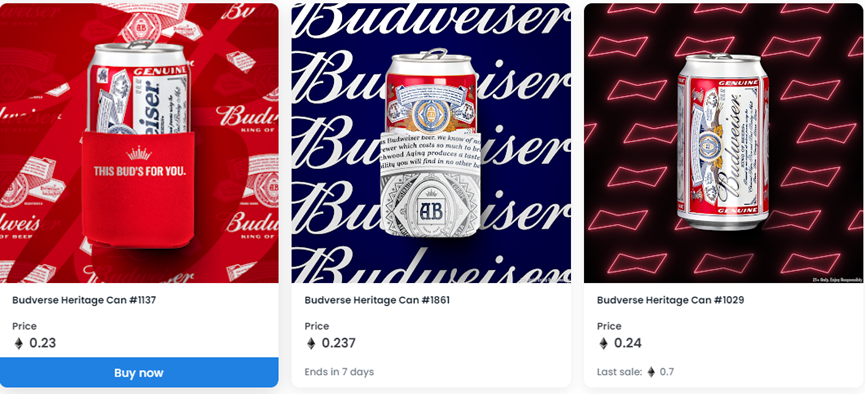
image description
Budverse Cans Heritage Edition Appearance
In January of this year, BudLight NEXT, a zero-carb brand under Budweiser, launched an NFT called "Bud Light N3XT Collection". Each NFT appearance combines the brand background and icons representing beer culture. The number of issues is 12,722. After purchasing this NFT, consumers will have the opportunity to vote on Bud Light NEXT merchandise, visit the Bud Light NEXT brand, participate in partner activities, and more.
secondary title
Fusion of reality and reality: NFT corresponding physical goods are sold simultaneously
Luxury brand Gucci goes deep into the encryption sector
Gucci's layout in the encryption sector not only includes supporting APE as a payment method, but also the launch of NFT products.
In 2021, Gucci launched the NFT series named "SUPERGUCCI" and "10KTF Gucci Grail", as well as the "Gucci Vault" series NFT of the metaverse store.
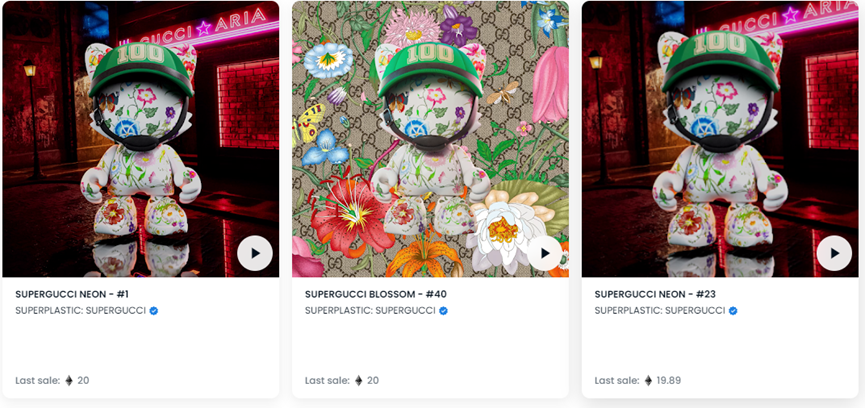
image description
SUPERGUCCI NFT Appearance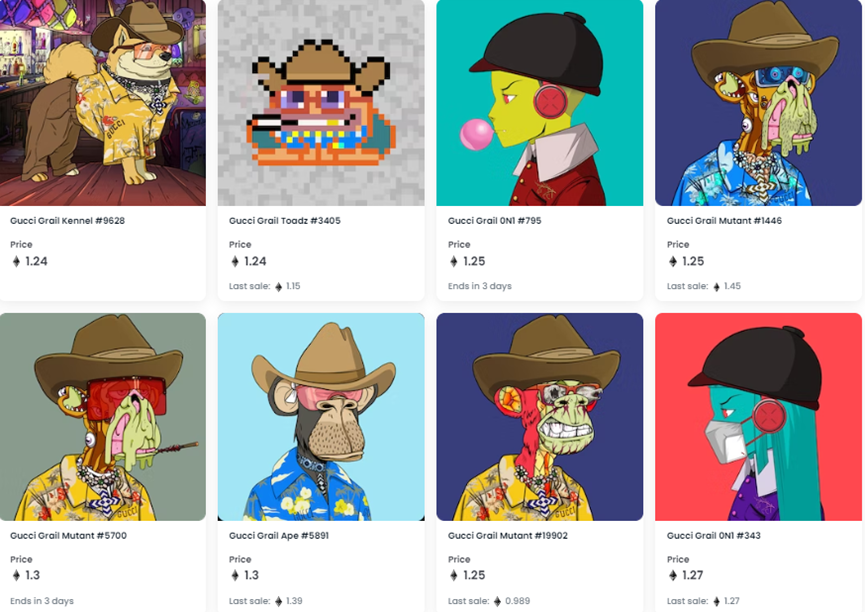
image description
In May of this year, Gucci announced that it will open the metaverse concept store "GUCCI Vault" on the virtual land purchased in Sandbox. It will launch brand NFT and retro bags in the concept store, and release virtual wearable items for The Sandbox players to purchase in the game. and dress.



